 REVIEW – June 1, 2024 | Yamaha P-225 digital piano – $699 internet price | The new P-225 portable digital piano recently came out and this is the 1st lower price portable digital piano under $1000 that Yamaha produces with some major changes over previous models. Major changes usually include key action, piano sound engine, pedaling, and/or speaker system. This recent model also has a new grand piano sound engine with some other new features that previous Yamaha portable digital pianos under $1000 have never had. This new model supersedes the previous P-125 series and is just slightly more money. at $699. But the question is…is it worth it?
REVIEW – June 1, 2024 | Yamaha P-225 digital piano – $699 internet price | The new P-225 portable digital piano recently came out and this is the 1st lower price portable digital piano under $1000 that Yamaha produces with some major changes over previous models. Major changes usually include key action, piano sound engine, pedaling, and/or speaker system. This recent model also has a new grand piano sound engine with some other new features that previous Yamaha portable digital pianos under $1000 have never had. This new model supersedes the previous P-125 series and is just slightly more money. at $699. But the question is…is it worth it? The main components to focus on when shopping for any digital piano in specific price ranges would be key action, piano sound, pedaling, and internal speaker system. In prior Yamaha portable digital pianos under $1000, Yamaha has had some decent digital pianos under $1000 in the past and they were fine, but they really did not challenge any real acoustic piano when it came to a decent piano playing experience or even other brands of digital pianos in my opinion. Those past Yamaha models included the P-45, P-115, P125, and a few other selected models.
The main components to focus on when shopping for any digital piano in specific price ranges would be key action, piano sound, pedaling, and internal speaker system. In prior Yamaha portable digital pianos under $1000, Yamaha has had some decent digital pianos under $1000 in the past and they were fine, but they really did not challenge any real acoustic piano when it came to a decent piano playing experience or even other brands of digital pianos in my opinion. Those past Yamaha models included the P-45, P-115, P125, and a few other selected models.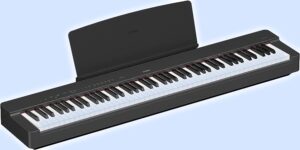 So when I first tried out this new P225 I was skeptical that I would like it as compared to other brands and models. Yamaha is a very good piano company and I like this brand, especially for the higher price Yamaha Clavinova digital pianos and their acoustic pianos. I was hoping for some noticeable changes in the P-225 over previous models and I am happy to report that Yamaha did their homework and they did, in fact, make some welcome improvements over their previous Yamaha digital pianos under $1000.
So when I first tried out this new P225 I was skeptical that I would like it as compared to other brands and models. Yamaha is a very good piano company and I like this brand, especially for the higher price Yamaha Clavinova digital pianos and their acoustic pianos. I was hoping for some noticeable changes in the P-225 over previous models and I am happy to report that Yamaha did their homework and they did, in fact, make some welcome improvements over their previous Yamaha digital pianos under $1000.KEY ACTION
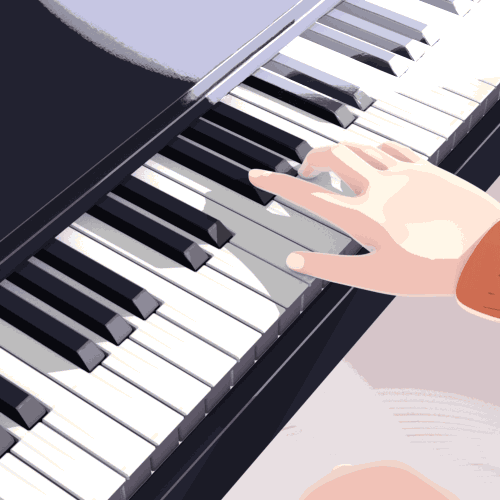 The most important to me in any digital piano is key action movement. The way the keys move up & down, the response of those keys, the mechanics and the ambient noise level of the keys, as well as the key balance from the front of the keys to the backs of the keys when you are playing them. All of these things are important.
The most important to me in any digital piano is key action movement. The way the keys move up & down, the response of those keys, the mechanics and the ambient noise level of the keys, as well as the key balance from the front of the keys to the backs of the keys when you are playing them. All of these things are important. The first thing I noticed about this new key action is that it is more responsive than their GHS (standard) key action in the other Yamaha portable models within this price range. This is because the key weight is more balanced from one key to the next and the down-weight and up-weight, when playing towards the front to middle of the keys, is more like a real piano and easier to play which is a food thing.
The first thing I noticed about this new key action is that it is more responsive than their GHS (standard) key action in the other Yamaha portable models within this price range. This is because the key weight is more balanced from one key to the next and the down-weight and up-weight, when playing towards the front to middle of the keys, is more like a real piano and easier to play which is a food thing. However, the compact nature of this new key action causes the touch weight to be noticeably firmer when pressing towards the backs of the black & white keys where flats and sharps are normally played. This noticeably heavier/firmer touch weight can cause finger, wrist, and forearm fatigue after playing for longer periods of time. This is all because the new compact key action (GHC) has shorter keys and the pivot points and fulcrum are different and truncated as compared to a real piano and as compared to other digital pianos out there.
However, the compact nature of this new key action causes the touch weight to be noticeably firmer when pressing towards the backs of the black & white keys where flats and sharps are normally played. This noticeably heavier/firmer touch weight can cause finger, wrist, and forearm fatigue after playing for longer periods of time. This is all because the new compact key action (GHC) has shorter keys and the pivot points and fulcrum are different and truncated as compared to a real piano and as compared to other digital pianos out there. Even though the keys are quite comfortable to play from the front to approx the just past the middle of the keys, as you play more towards the backs of the keys this is when when you’ll need noticeably more finger force to press down the keys. Regular length keys on other digital pianos with more natural pivot and fulcrum points do a better job in that way.
Even though the keys are quite comfortable to play from the front to approx the just past the middle of the keys, as you play more towards the backs of the keys this is when when you’ll need noticeably more finger force to press down the keys. Regular length keys on other digital pianos with more natural pivot and fulcrum points do a better job in that way. An improved aspect of this key action over the the Yamaha GHS key action is reduced “key noise.” What I mean by that is how much noise the keys make when they are being played and as the keys are moving up & down. There will always be some key noise as you are playing them because key actions are mechanical, so that’s normal.
An improved aspect of this key action over the the Yamaha GHS key action is reduced “key noise.” What I mean by that is how much noise the keys make when they are being played and as the keys are moving up & down. There will always be some key noise as you are playing them because key actions are mechanical, so that’s normal.PIANO SOUNDS
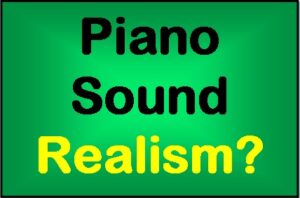 When it comes to piano sound realism, that can be a difficult thing to find in a digital piano, especially in this lower price range. Many of these lower priced portable digital pianos have piano sounds, but whether they actually sound like a real good acoustic piano is another story. All of the “off-brands” I have played have very artificial piano sounds in those digital pianos and most of them sound like toys.
When it comes to piano sound realism, that can be a difficult thing to find in a digital piano, especially in this lower price range. Many of these lower priced portable digital pianos have piano sounds, but whether they actually sound like a real good acoustic piano is another story. All of the “off-brands” I have played have very artificial piano sounds in those digital pianos and most of them sound like toys. Part of what makes the new piano sound in this model better than all the other previous P-model Yamaha digital pianos is the use of their newest CFX stereo piano sample combined with Virtual Resonance Modeling (VRM lite). The better, updated piano sound sample along with the VRM technology that adds in better and more natural piano resonances really makes a difference in the authenticity of the piano sound and I enjoyed playing it.
Part of what makes the new piano sound in this model better than all the other previous P-model Yamaha digital pianos is the use of their newest CFX stereo piano sample combined with Virtual Resonance Modeling (VRM lite). The better, updated piano sound sample along with the VRM technology that adds in better and more natural piano resonances really makes a difference in the authenticity of the piano sound and I enjoyed playing it.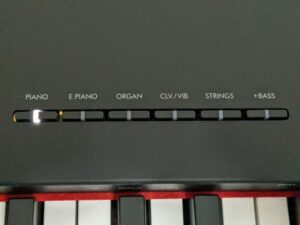 The ballad piano tone is extremely muted and mellow with a very small about of tonal dynamics. It may be useful to some people but it’s really much too muted for most piano music. The bright piano sound is very bright and useful for maybe cutting through other instrument sounds if playing along with other musicians. I think there will be some people who may use the other 3 piano sounds occasionally, but the 1st “grand” piano sound is the one that is the best of the four by far and the most useful as well. The first piano sound is selected by default when the piano first powers up.
The ballad piano tone is extremely muted and mellow with a very small about of tonal dynamics. It may be useful to some people but it’s really much too muted for most piano music. The bright piano sound is very bright and useful for maybe cutting through other instrument sounds if playing along with other musicians. I think there will be some people who may use the other 3 piano sounds occasionally, but the 1st “grand” piano sound is the one that is the best of the four by far and the most useful as well. The first piano sound is selected by default when the piano first powers up.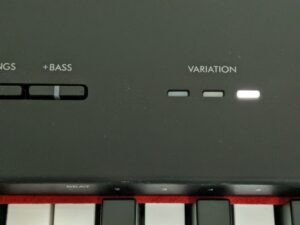 If you want the other piano sounds then you press the piano button on the control panel you get the next piano sound and a variation display will light up on the first LED light. Press the piano button again and the next piano sound comes up and is displayed with the next light. Press the piano button again and that next piano sound comes up with the next LED light being displayed until the variation lights go off which means you are back to the main grand piano sound. It’s fairly intuitive and easy to do.
If you want the other piano sounds then you press the piano button on the control panel you get the next piano sound and a variation display will light up on the first LED light. Press the piano button again and the next piano sound comes up and is displayed with the next light. Press the piano button again and that next piano sound comes up with the next LED light being displayed until the variation lights go off which means you are back to the main grand piano sound. It’s fairly intuitive and easy to do. Another important part of the piano sound that helps contribute to the overall realism is the sustain quality and decay time of the piano sound. A piano sound can be playing quickly with no sustain and that kind of playing is called staccato when you press a key quickly let go of it. The other type of piano sound is legato or holding down the key for a period of time or using the sustain/damper pedal and holding down the pedal to give you longer sustained notes that are currently being played. The included single sustain pedal will not trigger “half-damper” effect, but I expected that.
Another important part of the piano sound that helps contribute to the overall realism is the sustain quality and decay time of the piano sound. A piano sound can be playing quickly with no sustain and that kind of playing is called staccato when you press a key quickly let go of it. The other type of piano sound is legato or holding down the key for a period of time or using the sustain/damper pedal and holding down the pedal to give you longer sustained notes that are currently being played. The included single sustain pedal will not trigger “half-damper” effect, but I expected that. The amount of time the sustaining tone can continue when you press down the pedal or a key is very important. Acoustic pianos can have very long sustain times with natural resonances and smooth sustain time decay. Duplicating this sustain time, especially when using a sustain pedal, is very important. The new Yamaha CFX piano sample tied in with the new VRM resonances has increased the sustain quality and decay time for these new sounds and the result is more realistic piano tone. especially when it comes to playing slower, more legato music. So even that aspect of the piano sound has been improved and is quite nice.
The amount of time the sustaining tone can continue when you press down the pedal or a key is very important. Acoustic pianos can have very long sustain times with natural resonances and smooth sustain time decay. Duplicating this sustain time, especially when using a sustain pedal, is very important. The new Yamaha CFX piano sample tied in with the new VRM resonances has increased the sustain quality and decay time for these new sounds and the result is more realistic piano tone. especially when it comes to playing slower, more legato music. So even that aspect of the piano sound has been improved and is quite nice.POLYPHONY
 All digital pianos have a specification known as “polyphony.” Polyphony is a technical word that means “piano processing power” to help enable the piano sound to be more realistic and to also allow more complex music to be played with enough piano memory so that all notes can be played without “note dropout.” The P-225 has 192-note polyphony which is more than enough to play complex music and also for the piano sound to be more realistic.
All digital pianos have a specification known as “polyphony.” Polyphony is a technical word that means “piano processing power” to help enable the piano sound to be more realistic and to also allow more complex music to be played with enough piano memory so that all notes can be played without “note dropout.” The P-225 has 192-note polyphony which is more than enough to play complex music and also for the piano sound to be more realistic.INSTRUMENTAL SOUNDS
 The P-225 has a total of 24 instrument sounds on board and they are divided up into 6 sound groups/banks with 4 sound variations per sound groups. Each sound group has a dedicated button to select the sounds within that group/bank. You would select the individual sounds within that group in the way you do with the acoustic piano sound group, which I previously explained. So it’s easy to do.
The P-225 has a total of 24 instrument sounds on board and they are divided up into 6 sound groups/banks with 4 sound variations per sound groups. Each sound group has a dedicated button to select the sounds within that group/bank. You would select the individual sounds within that group in the way you do with the acoustic piano sound group, which I previously explained. So it’s easy to do. Overall, the individual instrument sounds are very good and quite enjoyable when played individually or in a layer or split. However, like all other Yamaha digital pianos, if you are layering 2 sounds together like piano & organ or piano & strings for examples, the 2nd sound in that layer will decay and fade out just like the piano sound when using the sustain pedal.
Overall, the individual instrument sounds are very good and quite enjoyable when played individually or in a layer or split. However, like all other Yamaha digital pianos, if you are layering 2 sounds together like piano & organ or piano & strings for examples, the 2nd sound in that layer will decay and fade out just like the piano sound when using the sustain pedal.SPECIAL EFFECTS
 REVERB – Most digital pianos have some sort of special effects such as “reverb” that will enhance the piano and instrument sounds by using the reverb effects to make those sounds fuller and somewhat richer in tone. Some of the reverb effects on the “cheap” brands sound like toys and are not good. Reverb effects along with other sound effects can be very useful in giving you other ways to add to the piano sounds and other sounds on the P-225. Reverb is the natural echo that occurs in larger rooms, halls, or big venues and you can hear this reverb-echo when you talk, when large crowds of people are there, or when music is being played.
REVERB – Most digital pianos have some sort of special effects such as “reverb” that will enhance the piano and instrument sounds by using the reverb effects to make those sounds fuller and somewhat richer in tone. Some of the reverb effects on the “cheap” brands sound like toys and are not good. Reverb effects along with other sound effects can be very useful in giving you other ways to add to the piano sounds and other sounds on the P-225. Reverb is the natural echo that occurs in larger rooms, halls, or big venues and you can hear this reverb-echo when you talk, when large crowds of people are there, or when music is being played. PIANO ROOM – Yamaha has a reverb feature called “Piano Room.” The Piano Room provides for different preset reverb effects which would be like playing piano in different size rooms or venues and hearing this echo effect. The different “rooms” would normally create different organic echo/reverb effects when sound is heard in that room from playing an instrument, talking, singing, etc.
PIANO ROOM – Yamaha has a reverb feature called “Piano Room.” The Piano Room provides for different preset reverb effects which would be like playing piano in different size rooms or venues and hearing this echo effect. The different “rooms” would normally create different organic echo/reverb effects when sound is heard in that room from playing an instrument, talking, singing, etc. SOUND BOOST – Yamaha includes this “sound boost” feature for people who may be playing in a band or in a room with a lot of people in it. The Sound Boost gives the piano sound somewhat of a boost to the overall clarity and volume of the piano sound when needed. This feature gives you the ability to quickly “cut through” the extra noise going on in a room or if you are trying to heard better playing along with other instruments. The Sound Boost does do its job and there is more clarity and volume that can be instantly applied to any piano sound you choose. It can also be used on the other instrument sounds such as harpsichord, electric piano, etc.
SOUND BOOST – Yamaha includes this “sound boost” feature for people who may be playing in a band or in a room with a lot of people in it. The Sound Boost gives the piano sound somewhat of a boost to the overall clarity and volume of the piano sound when needed. This feature gives you the ability to quickly “cut through” the extra noise going on in a room or if you are trying to heard better playing along with other instruments. The Sound Boost does do its job and there is more clarity and volume that can be instantly applied to any piano sound you choose. It can also be used on the other instrument sounds such as harpsichord, electric piano, etc.ADDITIONAL FEATURES
 DRUM RHYTHMS – There are 20 drum rhythms in this model which include swing, rock, jazz, Latin, waltz, march, Christmas rhythms, etc. Having drum rhythms can make playing music more fun and it also helps with your rhythm & timing. The drum rhythms actually sound pretty realistic. You can control the tempo and volume of those rhythms along with having a small intro & ending to each rhythm to give it more authenticity. This adds another dimension to your music. Being able to play along with these rhythms is definitely more fun than just have a metronome.
DRUM RHYTHMS – There are 20 drum rhythms in this model which include swing, rock, jazz, Latin, waltz, march, Christmas rhythms, etc. Having drum rhythms can make playing music more fun and it also helps with your rhythm & timing. The drum rhythms actually sound pretty realistic. You can control the tempo and volume of those rhythms along with having a small intro & ending to each rhythm to give it more authenticity. This adds another dimension to your music. Being able to play along with these rhythms is definitely more fun than just have a metronome. RHYTHMIC BASS PLAYER – Each of the 20 rhythms also has an optional bass player that you can select which will give you an appropriate bass accompaniment for each of the 20 drum rhythms. The bass notes for each drum rhythm are determined by the key or chord you play on your left hand. If you play a chord then the bass notes become more complex and sound more realistic. The bass accompaniment makes it sound like you have more of a band playing along with you as opposed to just having a drummer. From having Salsa bass accompaniment to Boogie Woogie, there’s a big variety to choose from and they sound realistic. As with these other special features, it is important that you use the Yamaha Smart Pianist app to access and control these drum/bass features.
RHYTHMIC BASS PLAYER – Each of the 20 rhythms also has an optional bass player that you can select which will give you an appropriate bass accompaniment for each of the 20 drum rhythms. The bass notes for each drum rhythm are determined by the key or chord you play on your left hand. If you play a chord then the bass notes become more complex and sound more realistic. The bass accompaniment makes it sound like you have more of a band playing along with you as opposed to just having a drummer. From having Salsa bass accompaniment to Boogie Woogie, there’s a big variety to choose from and they sound realistic. As with these other special features, it is important that you use the Yamaha Smart Pianist app to access and control these drum/bass features.
 METRONOME – A digital metronome is included which gives you a sound that counts off the timing you set for rhythm training. You can get 4/4, 3/4, 2/4, etc timing and there’s even a bell sound that you can apply to the metronome to let you hear the “downbeat” to know when to come in and helps you keep track of if you are on or off the beat. You can set the tempo of the metronome to any speed and volume while you are practicing your music.
METRONOME – A digital metronome is included which gives you a sound that counts off the timing you set for rhythm training. You can get 4/4, 3/4, 2/4, etc timing and there’s even a bell sound that you can apply to the metronome to let you hear the “downbeat” to know when to come in and helps you keep track of if you are on or off the beat. You can set the tempo of the metronome to any speed and volume while you are practicing your music.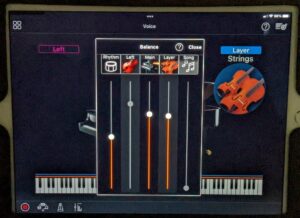 MIXER – Digital pianos have different ways of controlling the volume of the different sounds including when sounds are layered, split, if there is accompaniment sounds, drums, songs being played, etc. The P-225 has an actual volume control mixer built in to it and you are able to easily control the volume of each sound that has been selected along with the drum rhythms and song playback.
MIXER – Digital pianos have different ways of controlling the volume of the different sounds including when sounds are layered, split, if there is accompaniment sounds, drums, songs being played, etc. The P-225 has an actual volume control mixer built in to it and you are able to easily control the volume of each sound that has been selected along with the drum rhythms and song playback. OCTAVE CONTROL – The octave control feature will allow you to set the octave for each sound part you choose and are playing. As an example, maybe you want your main piano sound to be up 1 octave and you have a 2nd layered sound (such as choir) mixed with the piano and you want the choir sound to be down 1 whole octave. The piano and choir are mixed together but they are in different octaves.
OCTAVE CONTROL – The octave control feature will allow you to set the octave for each sound part you choose and are playing. As an example, maybe you want your main piano sound to be up 1 octave and you have a 2nd layered sound (such as choir) mixed with the piano and you want the choir sound to be down 1 whole octave. The piano and choir are mixed together but they are in different octaves. TRANSPOSE – Almost every digital piano has a transpose feature to let you change key up and and half steps so that you can modulate to any key that you need for vocals or just to modulate up when needed. There is even a dedicated virtual button in the app to let you instantly transpose the key up or down. The transpose feature also allows you to independently transpose a recorded song that you are playing to a different key separately from the keyboard transpose feature. This can be useful when playing along with a song and needing it to be in a different vocal range.
TRANSPOSE – Almost every digital piano has a transpose feature to let you change key up and and half steps so that you can modulate to any key that you need for vocals or just to modulate up when needed. There is even a dedicated virtual button in the app to let you instantly transpose the key up or down. The transpose feature also allows you to independently transpose a recorded song that you are playing to a different key separately from the keyboard transpose feature. This can be useful when playing along with a song and needing it to be in a different vocal range. KEY TOUCH SENSITIVITY – This feature lets you change the key sensitivity to hard, medium, or soft. So if you don’t have much strength in your fingers then you may want to put the touch sensitivity on “soft” so that when you push on the keys the sound volume will come in a bit more quickly and be louder. If you have very strong fingers then you may want to do the opposite setting and put it on “hard.” Most people just leave it on normal Almost all digital pianos have this touch sensitivity feature so it is not unusual.
KEY TOUCH SENSITIVITY – This feature lets you change the key sensitivity to hard, medium, or soft. So if you don’t have much strength in your fingers then you may want to put the touch sensitivity on “soft” so that when you push on the keys the sound volume will come in a bit more quickly and be louder. If you have very strong fingers then you may want to do the opposite setting and put it on “hard.” Most people just leave it on normal Almost all digital pianos have this touch sensitivity feature so it is not unusual. REGISTRATIONS – Some digital pianos have this feature and some don’t. Registrations is another name for “settings memory.” This feature is very useful to have because it will let you save your favorite sound setups that you have created including specific layers, splits, reverb settings, volumes, etc. You just setup the sounds and settings that you want and then you save them to the “registration memories” and then next time you want to use that setting again you do not have to recreate it. You just go to your “registration menu” and pull up that saved setting. You can even name your setting so you can more easily find it the next time. This is very cool to have and is done in the Smart Pianist app.
REGISTRATIONS – Some digital pianos have this feature and some don’t. Registrations is another name for “settings memory.” This feature is very useful to have because it will let you save your favorite sound setups that you have created including specific layers, splits, reverb settings, volumes, etc. You just setup the sounds and settings that you want and then you save them to the “registration memories” and then next time you want to use that setting again you do not have to recreate it. You just go to your “registration menu” and pull up that saved setting. You can even name your setting so you can more easily find it the next time. This is very cool to have and is done in the Smart Pianist app.SONG PLAY, LESSONS, RECORDING & SHEET MUSIC
 Within the P-225 is a music library consisting of 50 Classic songs (mostly classical music), hundreds of lesson book songs for various well known lesson books, and 21 “demo songs” demonstrating the different instrument sounds. Beyond being able to hear all these songs, you can control them in various ways. You can play along live with these songs, you can change the tempo of the songs, and you can transpose these songs to different keys.
Within the P-225 is a music library consisting of 50 Classic songs (mostly classical music), hundreds of lesson book songs for various well known lesson books, and 21 “demo songs” demonstrating the different instrument sounds. Beyond being able to hear all these songs, you can control them in various ways. You can play along live with these songs, you can change the tempo of the songs, and you can transpose these songs to different keys. You get to hear the song from the Yamaha song library you have chosen and then see the sheet music from that song as it plays. You can try to learn that song with both left hand and right hand. There is an option to “mute” either the left hand piano sound or right hand piano sound so that you can play that part live along with the other hand that is prerecorded. So it would be essentially like one person was playing one of the two parts and you are playing the other part. This feature helps when trying to learn one hand at a time while the other hand is still being heard. When you add up all the things the virtual sheet music and songbooks can do, this is a great way to have fun and also learn music at the same time.
You get to hear the song from the Yamaha song library you have chosen and then see the sheet music from that song as it plays. You can try to learn that song with both left hand and right hand. There is an option to “mute” either the left hand piano sound or right hand piano sound so that you can play that part live along with the other hand that is prerecorded. So it would be essentially like one person was playing one of the two parts and you are playing the other part. This feature helps when trying to learn one hand at a time while the other hand is still being heard. When you add up all the things the virtual sheet music and songbooks can do, this is a great way to have fun and also learn music at the same time. Another very cool thing the P-225 song section can do is to record your playing as a MIDI song file while you play a song on both left & right hand and then be able to save that song you recorded. Once you do that then it will play back that song you recorded to any tempo, transposed key, and volume and you can see the sheet music of that song. The sheet music is not necessarily accurate all the time when it plays back you song, but it gives you a general idea of what you did.
Another very cool thing the P-225 song section can do is to record your playing as a MIDI song file while you play a song on both left & right hand and then be able to save that song you recorded. Once you do that then it will play back that song you recorded to any tempo, transposed key, and volume and you can see the sheet music of that song. The sheet music is not necessarily accurate all the time when it plays back you song, but it gives you a general idea of what you did. The P-225 has a “Duo” feature that electronically splits the 88 keys into two 44-key sections. When you do this then both of those 44-key sections will sound exactly the same and be in the same octaves. This feature is more common these days and is used when two people (students) want to practice the same song at the same time and then each person is limited to a 44-key section.
The P-225 has a “Duo” feature that electronically splits the 88 keys into two 44-key sections. When you do this then both of those 44-key sections will sound exactly the same and be in the same octaves. This feature is more common these days and is used when two people (students) want to practice the same song at the same time and then each person is limited to a 44-key section. A more unusual song playback feature that is in the Yamaha Smart Pianist app that I like is the ability to playback any MP3 audio song files that you have in your device song library. You would be able to hear those songs through the piano internal speaker system and then play along live with those songs. It’s like having a band playing through the piano and you are a part of it. The Casio piano company also has a feature like this in their proprietary app called Casio Music Space. So Yamaha is not the only one to have that feature.
A more unusual song playback feature that is in the Yamaha Smart Pianist app that I like is the ability to playback any MP3 audio song files that you have in your device song library. You would be able to hear those songs through the piano internal speaker system and then play along live with those songs. It’s like having a band playing through the piano and you are a part of it. The Casio piano company also has a feature like this in their proprietary app called Casio Music Space. So Yamaha is not the only one to have that feature. Yamaha also has an exclusive technology that will instantly download an active chord chart of the MP3 song file you have downloaded from your device. Then when you play along with the song you can see which chords are playing by the chord symbols and when those chords are coming up in the song. It works pretty good most of the time on most songs from your MP3 audio song files. If you like playing by “chords” then it’s a very practical way of learning the chords in that song.
Yamaha also has an exclusive technology that will instantly download an active chord chart of the MP3 song file you have downloaded from your device. Then when you play along with the song you can see which chords are playing by the chord symbols and when those chords are coming up in the song. It works pretty good most of the time on most songs from your MP3 audio song files. If you like playing by “chords” then it’s a very practical way of learning the chords in that song.FUNCTION/FEATURE CONTROLS
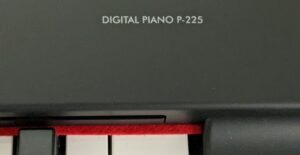 Every digital piano has a way to select functions and features. Some have actual buttons on the top of the piano, some have a smooth surface with built-in embedded sensors (like a phone/tablet), and some digital pianos have actual buttons mixed with a function button where you hold that button while pressing a certain key to get a specific feature or function.
Every digital piano has a way to select functions and features. Some have actual buttons on the top of the piano, some have a smooth surface with built-in embedded sensors (like a phone/tablet), and some digital pianos have actual buttons mixed with a function button where you hold that button while pressing a certain key to get a specific feature or function. Yamaha uses a combination of buttons and function/keys to activate features. Overall the Yamaha control panel is simple to use and fairly intuitive. You can change instrument sounds, do basic recording, select a drum rhythm or metronome, and play the demo songs from a button. There are also keys set up to control metronome tempo and a few other aspects of the piano when pressing a function button at the same time.
Yamaha uses a combination of buttons and function/keys to activate features. Overall the Yamaha control panel is simple to use and fairly intuitive. You can change instrument sounds, do basic recording, select a drum rhythm or metronome, and play the demo songs from a button. There are also keys set up to control metronome tempo and a few other aspects of the piano when pressing a function button at the same time. On the front of the P-225 just under the keys are some functions which are written on the rail. When you hold the function button on the top control panel and push a specific key for that function then you will get it. This includes metronome tempo, metronome volume, sound boost, speaker on/off, and a couple of other things. So there is access to a few internal features from the control panel in this way, but the Smart Pianist app is definitely the way to go when it comes to controlling features & functions
On the front of the P-225 just under the keys are some functions which are written on the rail. When you hold the function button on the top control panel and push a specific key for that function then you will get it. This includes metronome tempo, metronome volume, sound boost, speaker on/off, and a couple of other things. So there is access to a few internal features from the control panel in this way, but the Smart Pianist app is definitely the way to go when it comes to controlling features & functionsSMART PIANIST APP
 However, other than changing instrument sounds from the control panel I would highly recommend using the Yamaha Smart Pianist app on your external device (tablet or phone). The app not only lets you more intuitively manage and manipulate those features, but you can access functions and features that you really cannot do from the piano controls. Plus, selecting and changing the instruments sounds from the app is much easier, especially when layering or splitting 2 sounds together.
However, other than changing instrument sounds from the control panel I would highly recommend using the Yamaha Smart Pianist app on your external device (tablet or phone). The app not only lets you more intuitively manage and manipulate those features, but you can access functions and features that you really cannot do from the piano controls. Plus, selecting and changing the instruments sounds from the app is much easier, especially when layering or splitting 2 sounds together. One of the most noticeable things about this app after you open it up is the big image of a grand piano. That grand piano is the main grand sound in the P-225. When you swipe the image to the right then you get the bright piano sound. If you want access to all 4 piano sounds then you go the the instrument sound library page and select the piano from there. You would also select the other instrument sounds from there as well such as organs, strings, etc. This is very easy to do and obviously quite visual. You can also access most of the other controls and pages from that main piano page using the icons below and above the piano image.
One of the most noticeable things about this app after you open it up is the big image of a grand piano. That grand piano is the main grand sound in the P-225. When you swipe the image to the right then you get the bright piano sound. If you want access to all 4 piano sounds then you go the the instrument sound library page and select the piano from there. You would also select the other instrument sounds from there as well such as organs, strings, etc. This is very easy to do and obviously quite visual. You can also access most of the other controls and pages from that main piano page using the icons below and above the piano image.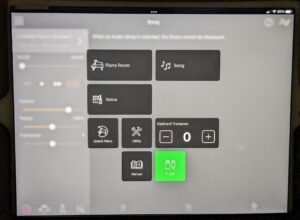 So what else can the Smart Pianist app do? It has a main control page that takes you to the other page functions. You just touch the sub headings to get to those features and then you can access them. It can do a lot! As I have already mentioned, it can more easily let you layer and split two sounds together in various combinations, it can let you change instrument octave potions, transpose keys, it lets you control the recording and playback feature, allows you to save custom settings, and change effects/reverb settings along with using the digital mixer controls to set volume levels.
So what else can the Smart Pianist app do? It has a main control page that takes you to the other page functions. You just touch the sub headings to get to those features and then you can access them. It can do a lot! As I have already mentioned, it can more easily let you layer and split two sounds together in various combinations, it can let you change instrument octave potions, transpose keys, it lets you control the recording and playback feature, allows you to save custom settings, and change effects/reverb settings along with using the digital mixer controls to set volume levels. When you layer or split two sounds together or apart, there are visual images on the main piano page where you select that 2nd sound. When you touch that icon it will bring up the last 2nd sound (layer/split that you had used. If you want a new sound for the layer or split then touching that image will take you directly to the instrument library where you can make your selection. Easy to do.
When you layer or split two sounds together or apart, there are visual images on the main piano page where you select that 2nd sound. When you touch that icon it will bring up the last 2nd sound (layer/split that you had used. If you want a new sound for the layer or split then touching that image will take you directly to the instrument library where you can make your selection. Easy to do.CONNECTIVITY
 There are many ways to connect to the P-225 with regard to built-in hardware along with wireless connectivity. This model has two 1/4″ stereo headphone jacks in the front of the piano under the right side of the keyboard for private practice using headphones. There are also two audio/Aux output jacks on the back of the piano so that you can connect to an external speaker system. There is a 1/4″ jack to connect a separate sustain pedal and a proprietary input connector to connect an optional Yamaha triple pedal unit to it. In most cases the connectivity hardware on this model would be enough for most people.
There are many ways to connect to the P-225 with regard to built-in hardware along with wireless connectivity. This model has two 1/4″ stereo headphone jacks in the front of the piano under the right side of the keyboard for private practice using headphones. There are also two audio/Aux output jacks on the back of the piano so that you can connect to an external speaker system. There is a 1/4″ jack to connect a separate sustain pedal and a proprietary input connector to connect an optional Yamaha triple pedal unit to it. In most cases the connectivity hardware on this model would be enough for most people. The P-225 also has connectivity for external digital devices such as computers, iPads, phones, etc. One of those connections is a USB MIDI output to device so that the P-225 can “talk to” an external device that uses apps, programs, etc. Most digital pianos these days have a USB MIDI output connector. However, this USB port can also transmit an audio signal as well. This means, for example, that if you are using an music related app, a YouTube music video, or a song from your device music library, that you will be able to hear the audio portion of that app or music through the internal P-225 speaker system.
The P-225 also has connectivity for external digital devices such as computers, iPads, phones, etc. One of those connections is a USB MIDI output to device so that the P-225 can “talk to” an external device that uses apps, programs, etc. Most digital pianos these days have a USB MIDI output connector. However, this USB port can also transmit an audio signal as well. This means, for example, that if you are using an music related app, a YouTube music video, or a song from your device music library, that you will be able to hear the audio portion of that app or music through the internal P-225 speaker system. The final connectivity feature is Bluetooth audio wireless streaming. This is the first time Yamaha has included this technology in their lower priced portable digital pianos. The Bluetooth feature is built in to the piano and you simply open up your external device and connect (pair) that device with the P-225 and then you can have all of your music/audio from your external device streaming in stereo through the P-225 internal speaker system.
The final connectivity feature is Bluetooth audio wireless streaming. This is the first time Yamaha has included this technology in their lower priced portable digital pianos. The Bluetooth feature is built in to the piano and you simply open up your external device and connect (pair) that device with the P-225 and then you can have all of your music/audio from your external device streaming in stereo through the P-225 internal speaker system.INTERNAL SPEAKER SYSTEM
 The P-225 has a very good internal stereo speaker system with 14 watts total power going through 4 speakers with 2 of those speakers being oval and a bit larger at approx 5″ and two being small tweeters at approx 2″ in size. The sound comes out the back of the piano as well as through 2 small front ports in the front of the piano above the left and right side keys. In my opinion this internal speaker system is optimized quite well with good frequency range and it has plenty of volume coming out.
The P-225 has a very good internal stereo speaker system with 14 watts total power going through 4 speakers with 2 of those speakers being oval and a bit larger at approx 5″ and two being small tweeters at approx 2″ in size. The sound comes out the back of the piano as well as through 2 small front ports in the front of the piano above the left and right side keys. In my opinion this internal speaker system is optimized quite well with good frequency range and it has plenty of volume coming out.
 With this in mind the Roland speaker system does not sound good to me in the way the piano sound comes out. The speakers are placed under the Roland piano pointing towards the floor instead of in front and behind the piano like the Yamaha has. The Roland speaker system makes the piano sound more muffled and distant and not real when coming out.
With this in mind the Roland speaker system does not sound good to me in the way the piano sound comes out. The speakers are placed under the Roland piano pointing towards the floor instead of in front and behind the piano like the Yamaha has. The Roland speaker system makes the piano sound more muffled and distant and not real when coming out.FINAL THOUGHTS
 The P-225 cabinet measurements are approx 52′ wide x 5″ high x 11″ deep. It weighs 25.5 lbs. The P-225 also includes a music rest that holds the sheet music. That music rest measures 23″ wide x 8″ high x 1.25″ deep and it fits into a long slot on the top of the piano along the back. The music rest is a good larger size and will support sheet music and music books.
The P-225 cabinet measurements are approx 52′ wide x 5″ high x 11″ deep. It weighs 25.5 lbs. The P-225 also includes a music rest that holds the sheet music. That music rest measures 23″ wide x 8″ high x 1.25″ deep and it fits into a long slot on the top of the piano along the back. The music rest is a good larger size and will support sheet music and music books. Overall I really do like this model when it comes to this new key action, piano sound, pedaling, and the sound output. The various “bells & whistles” features are good and very usable, and not only can make it more fun to play piano but it helps when creating and exploring different styles of music. But if all you really want to do is mostly play piano on it, then the P-225 should serve you well whether you are a beginner, intermediate, or advanced player and you want or need to be in this price range and have a portable digital piano.
Overall I really do like this model when it comes to this new key action, piano sound, pedaling, and the sound output. The various “bells & whistles” features are good and very usable, and not only can make it more fun to play piano but it helps when creating and exploring different styles of music. But if all you really want to do is mostly play piano on it, then the P-225 should serve you well whether you are a beginner, intermediate, or advanced player and you want or need to be in this price range and have a portable digital piano.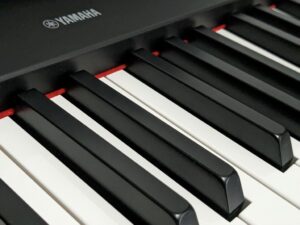 However, it is important to know that the new key action that Yamaha is using in this model is a “compact” key action which makes the keys shorter, especially the white keys, and therefore the balance of the keys from front to back are not near as realistic as other key actions in higher price ranges. If you are a beginner and you are basically playing on mostly white keys then you won’t notice these shortcomings and will be fine. But once you are playing at more intermediate or advanced skill levels, then you will notice it takes noticeably more finger force to play towards the backs of the keys as opposed to the front of the keys. The more even and balanced the keys are, the better.
However, it is important to know that the new key action that Yamaha is using in this model is a “compact” key action which makes the keys shorter, especially the white keys, and therefore the balance of the keys from front to back are not near as realistic as other key actions in higher price ranges. If you are a beginner and you are basically playing on mostly white keys then you won’t notice these shortcomings and will be fine. But once you are playing at more intermediate or advanced skill levels, then you will notice it takes noticeably more finger force to play towards the backs of the keys as opposed to the front of the keys. The more even and balanced the keys are, the better. The key pivot points and fulcrum has to be in a different place when it comes to compact key actions like this. The noticeably extra finger force it takes to press down on the keys, especially when playing individual flat & sharp notes and chords with flats & sharps, can add to finger, wrist, and forearm fatigue after playing for a while. This is a mechanical key action and nothing can be done to change the way it physically moves. Again, beginners will not notice this issue because they are playing simple songs mostly on the front of the white keys. For more advanced players the keys are still very playable, but nevertheless, you may not like it as much as you would playing on longer keys in the better key actions of other some brands.
The key pivot points and fulcrum has to be in a different place when it comes to compact key actions like this. The noticeably extra finger force it takes to press down on the keys, especially when playing individual flat & sharp notes and chords with flats & sharps, can add to finger, wrist, and forearm fatigue after playing for a while. This is a mechanical key action and nothing can be done to change the way it physically moves. Again, beginners will not notice this issue because they are playing simple songs mostly on the front of the white keys. For more advanced players the keys are still very playable, but nevertheless, you may not like it as much as you would playing on longer keys in the better key actions of other some brands. One such brand and model that has a noticeably upgraded and more realistic key action is the Kawai ES120. That model sells for $300 more at $949, but in my opinion it is worth the extra expense. You get a much more realistic key action (something you can also advance in your playing skills), an arguably more realistic piano sound, and an impressive internal speaker system along with other usable features and functions. You might want to check out my review of that model at the following link: Kawai ES120 Review
One such brand and model that has a noticeably upgraded and more realistic key action is the Kawai ES120. That model sells for $300 more at $949, but in my opinion it is worth the extra expense. You get a much more realistic key action (something you can also advance in your playing skills), an arguably more realistic piano sound, and an impressive internal speaker system along with other usable features and functions. You might want to check out my review of that model at the following link: Kawai ES120 Review Another digital piano that is definitely worth consideration over the Yamaha P-225 is the popular Casio PX-S3100. This Casio model also has a compact key action like the Yamaha but it is vastly upgraded when it comes to all the additional features (bells & whistles). It has a few impressive grand piano sounds in it along with 700 instrument sounds and 250 rhythms and accompaniments. This model also includes its proprietary Casio Music Space app. This Casio model sells on-line for $879 so it’s just $180 more than the Yamaha P-225. Please read my detailed review of the Casio PX-S3100 at the following link: Casio PX-S3100 Review
Another digital piano that is definitely worth consideration over the Yamaha P-225 is the popular Casio PX-S3100. This Casio model also has a compact key action like the Yamaha but it is vastly upgraded when it comes to all the additional features (bells & whistles). It has a few impressive grand piano sounds in it along with 700 instrument sounds and 250 rhythms and accompaniments. This model also includes its proprietary Casio Music Space app. This Casio model sells on-line for $879 so it’s just $180 more than the Yamaha P-225. Please read my detailed review of the Casio PX-S3100 at the following link: Casio PX-S3100 ReviewIf you want more info on new digital pianos and LOWER PRICES than internet discounts or Amazon, please email me at tim@azpianowholesale.com or call direct at 602-571-1864.





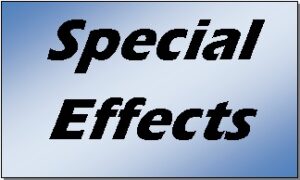










Nice review!
How do you compare the 2 compact actions on the market?
GHC vs Casio Hybrid Smart(S5000/S6000/S7000)
Great review as always.
Do you know the down-weigjt and up-weight of the acrion?
How would you rank this action in comparison with Kawai ES-120 and Casio PX-S5/6/7000 regarding playability and connection to the sound?